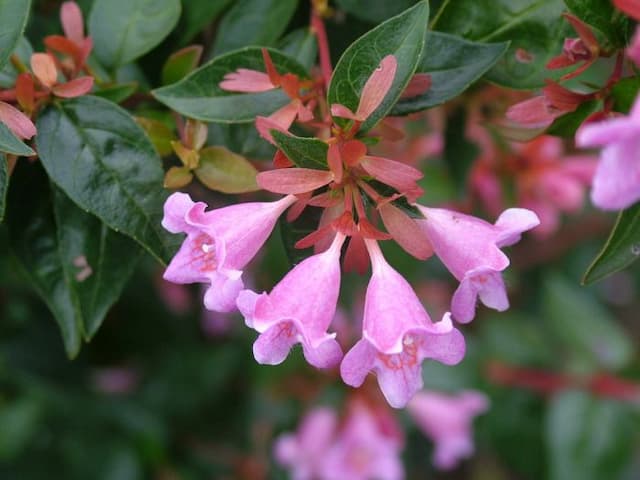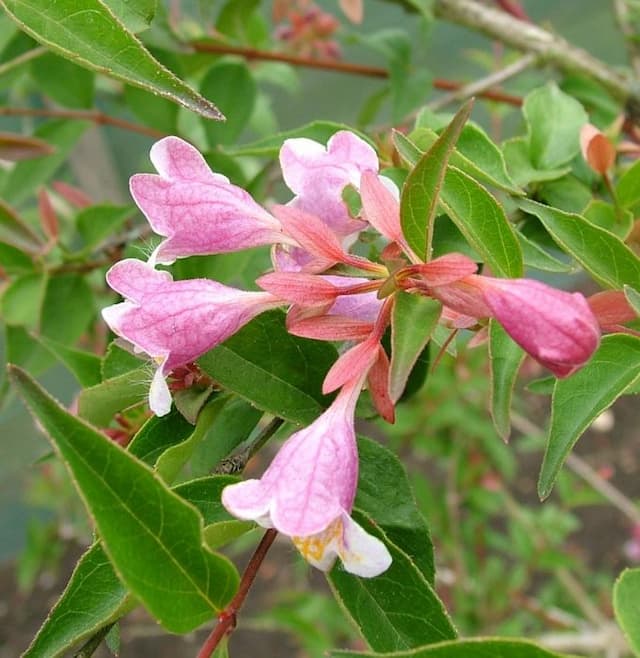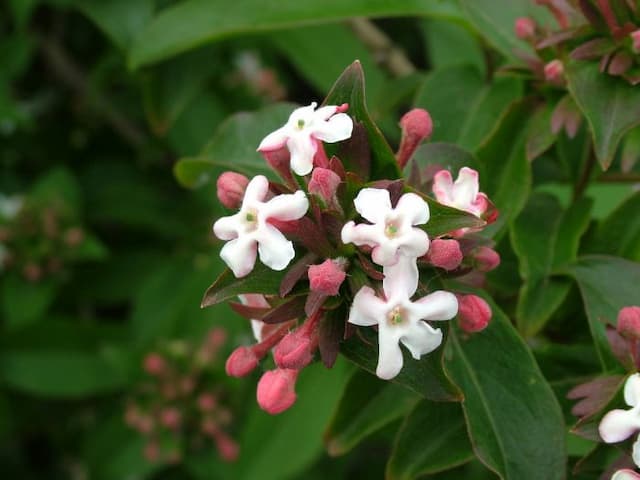Seven-Son Flower Heptacodium miconioides Tianshan = 'Minhep' (PBR)

ABOUT
The Seven Sons Flower, commonly referred to by its botanical name Heptacodium miconioides Tianshan 'Minhep', is a visually striking plant. It is best known for its layered and tiered appearance. The foliage consists of bright green leaves that provide a lush backdrop for the blooms and continue to add visual interest throughout the spring and summer. The most striking feature of this plant is its flower display which typically occurs in the late summer to early autumn. The small, fragrant, white flowers are arranged in clusters called cymes, which provide a soft and delicate appearance. After the flowers have bloomed, they leave behind calyces, initially light pink and deepening to a darker red as the season progresses. These colorful calyces provide extended interest, even after the actual petals have fallen. In addition to the flowers, this plant may also produce small, non-showy fruits. The bark is also noteworthy, exfoliating with age to reveal a brown to tan underlayer that can add to the plant’s winter interest. Overall, the Seven Sons Flower has a multi-dimensional appeal with its combination of aromatic flowers, attractive leafage, and textured bark, making it a versatile and decorative choice for many garden settings.
About this plant
 Names
NamesFamily
Caprifoliaceae
Synonyms
Seven Son Flower, Autumn Lilac
Common names
Heptacodium miconioides, Heptacodium jasminoides.
 Toxicity
ToxicityTo humans
The seven-son flower, known botanically as Heptacodium miconioides, is not commonly known to be toxic to humans. There is limited information available on specific symptoms of poisoning because it is not typically regarded as a poisonous plant. Ingesting any part of the seven-son flower is unlikely to result in serious consequences for humans, but as with any plant, individual allergic reactions or sensitivities could occur.
To pets
The seven-son flower, or Heptacodium miconioides, is also not commonly known to be toxic to pets. It is not usually listed among plants that cause serious harm or poisoning symptoms when ingested by pets such as dogs or cats. However, ingestion of any plant material could potentially cause mild stomach upset in some pets due to individual sensitivities. If a pet ingests this plant and shows signs of distress, it is advisable to consult a veterinarian.
 Characteristics
CharacteristicsLife cycle
Perennials
Foliage type
Deciduous
Color of leaves
Green
Flower color
White
Height
15-20 feet (4.5-6 meters)
Spread
6-10 feet (1.8-3 meters)
Plant type
Shrub
Hardiness zones
5
Native area
China
Benefits
 General Benefits
General Benefits- Aesthetic Appeal: An ornamental plant featuring white fragrant flowers that bloom in late summer to autumn, providing visual interest.
- Attracts Wildlife: Serves as a food source for bees, butterflies, and other pollinating insects.
- Seasonal Interest: Offers a three-season display, with flowers in late summer, colorful calyces and foliage in fall, and peeling bark in winter.
- Drought Tolerance: Once established, it is tolerant of moderate drought, reducing the need for frequent watering after the initial establishment period.
- Low-Maintenance: Requires minimal care beyond basic needs, making it suitable for gardening enthusiasts of all levels.
- Adaptability: Capable of growing in a range of soil types, although it prefers well-drained soils with average fertility.
- Fall Coloration: Its leaves and persistent sepals turn shades of purple and red in the autumn, providing additional seasonal color.
- Small Stature: With a moderate height, it is suitable for residential gardens without risk of overpowering smaller spaces.
 Medical Properties
Medical PropertiesThis plant is not used for medical purposes.
 Air-purifying Qualities
Air-purifying QualitiesThis plant is not specifically known for air purifying qualities.
 Other Uses
Other Uses- The Seven-Son Flower can be used as a specimen plant in gardens to create a striking focal point due to its fragrant flowers and peeling bark.
- It can be planted in parks and large landscapes for fall interest, as it provides late-season blooms after most other plants have finished flowering.
- The plant is well-suited for creating natural borders or screens because of its height and density of foliage.
- In regions where bees are in decline, Heptacodium miconioides can serve as an important late-season food source for pollinators.
- Because of its robust root system, the Seven-Son Flower can be used in erosion control on slopes and banks.
- The dried branches of Heptacodium miconioides can be used in floral arrangements or as part of decorative wreaths.
- This species' distinctive bark and branch structure can be used to add architectural interest in winter gardens when the leaves have fallen.
- The Seven-Son Flower can be trained as an espalier against a flat surface or garden wall, showcasing its form and flowers in a creative way.
- Its canopy can provide light shade for understory plants that require protection from the harsh midday sun.
- In urban environments, Heptacodium miconioides can act as a habitat for urban wildlife, offering shelter and food to birds and insects.
Interesting Facts
 Feng Shui
Feng ShuiThe Seven Son Flower is not used in Feng Shui practice.
 Zodiac Sign Compitability
Zodiac Sign CompitabilityThe Seven Son Flower is not used in astrology practice.
 Plant Symbolism
Plant Symbolism- Persistence and Vitality - Heptacodium miconioides, also known as Seven-Son Flower, typically represents the ability to thrive and grow continuously, symbolizing the perseverance of life through different conditions.
- Elegance and Simplicity - With its delicate white flowers and simple form, the Seven-Son Flower often stands for elegance and unassuming beauty, celebrating the virtues of simplicity.
- Renewal and Rebirth - Since the Seven-Son Flower has a second stage of interest when its calyces turn a rosy-red in late summer and autumn, it symbolizes renewal and the cyclical nature of life.
- Adaptation - Native to China and adaptable to various environments, the Seven-Son Flower may symbolize the ability to adapt to change and new circumstances with ease.
 Water
WaterSeven Son Flower should be watered thoroughly whenever the top inch of soil feels dry to the touch. In general, once a week should be sufficient, but this may vary depending on weather conditions and the plant's environment. It's important to avoid over-watering, as consistently soggy soil can lead to root rot. When watering, provide enough water to allow moisture to reach the deep roots without flooding the plant – this could be about 1 to 1.5 gallons depending on the size of the plant and the environmental conditions. During the winter months, reduce frequency as the plant's water requirements will decrease.
 Light
LightSeven Son Flower thrives best in full sun to partial shade. The ideal spot for this plant is an area where it can receive at least six hours of direct sunlight each day. However, in regions with extremely hot summers, some afternoon shade might be beneficial to prevent scorching.
 Temperature
TemperatureSeven Son Flower is hardy in a range of temperatures but performs best in the range of 50°F to 75°F. It can survive minimum winter temperatures down to about -20°F once established. The maximum temperature tolerated is typically around 90°F, but it's crucial to ensure adequate moisture during hotter months to prevent stress.
 Pruning
PruningSeven Son Flower should be pruned for shaping and removal of dead or damaged wood. Pruning is best done in late winter to early spring before new growth starts. Pruning at this time allows for a vigorous burst of growth in spring and ensures blooms are not accidentally removed, as the flowers form on new wood. Prune sparingly to maintain the natural form of the shrub.
 Cleaning
CleaningAs needed
 Soil
SoilSeven-Son Flower thrives in well-draining soil with a pH between 6.0 and 7.5. A mix containing loamy soil, compost, and some perlite or sand can provide good drainage and nutrients. Mulching helps retain moisture.
 Repotting
RepottingThe Seven-Son Flower, being a larger shrub, does not typically require frequent repotting. Planting in the ground is preferable, but if potted, repotting every few years or when rootbound is sufficient.
 Humidity & Misting
Humidity & MistingSeven-Son Flower is adaptable to a range of humidity levels but prefers moderate conditions. It tolerates the average outdoor humidity well, with no special requirements in this regard.
 Suitable locations
Suitable locationsIndoor
Ensure bright light and room to grow.
Outdoor
Full sun to partial shade, shelter from strong winds.
Hardiness zone
5-9 USDA
 Life cycle
Life cycleHeptacodium miconioides, commonly known as the Seven-Son Flower, begins its life cycle with germination, where seeds establish in soil under suitable conditions of temperature and moisture. It progresses to the seedling stage, where initial growth develops the first true leaves and a root system to sustain the plant. The juvenile phase follows, during which the plant develops a sturdy stem, a branching structure, and matures into a flowering plant over the course of several years. Flowering occurs in late summer to early fall, presenting clusters of fragrant white flowers that attract pollinators, crucial for successful reproduction. After flowering, the plant produces fruits in the form of small drupes, which can be dispersed by birds, leading to the potential germination of new plants. The Seven-Son Flower is a deciduous shrub and will experience seasonal leaf drop in the autumn followed by a period of dormancy in the winter, before the cycle begins anew with the return of spring.
 Propogation
PropogationPropogation time
Spring to early summer
Propogation: The most popular method of propagating the Seven Sons Flower (Heptacodium miconioides Tianshan = 'Minhep' (PBR)) is through softwood cuttings. This technique is typically carried out in late spring or early summer when the plant's new growth is still soft and flexible. Cuttings should be about 4 to 6 inches long with several leaves, and the lower end should be cut just below a node. The leaves on the lower half of the cutting are removed to reduce moisture loss. The bottom end of the cutting is often dipped in rooting hormone before being placed in a well-drained potting mix. The potting vessel should be kept moist and in a warm environment with indirect light to encourage rooting, which may take several weeks. A plastic cover or dome over the pot can help maintain humidity levels crucial for successful rooting.







![Himalayan honeysuckle [Golden Lanterns]](/_next/image?url=https%3A%2F%2Fplants-admin.emdemapps.com%2Fimages%2Fplants%2F%2Fimages%2F604b55302cc87.png&w=640&q=75)

